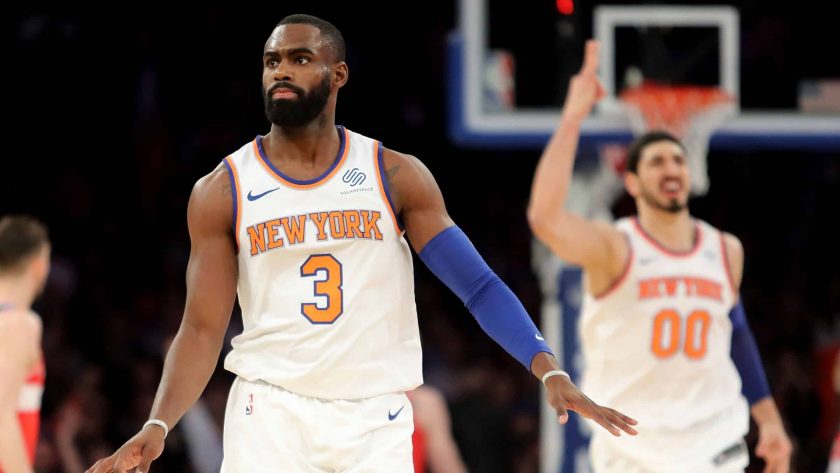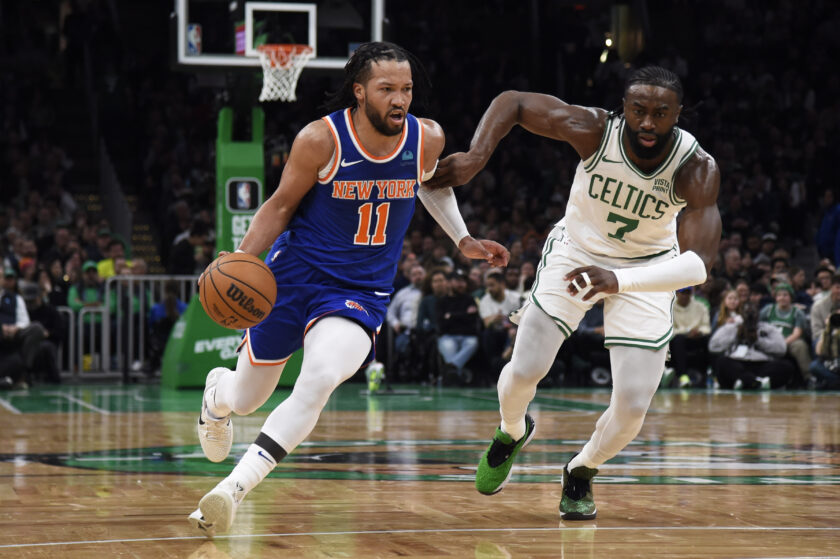New York Knicks report cards: Grading the big names

The New York Knicks season was underwhelming, to say the least, but how did the biggest names on the team fare this season?
This season did not go as planned for the New York Knicks. They were well out of playoff contention by the All-Star break, their franchise player tore his ACL, and they have been one of the worst teams in the NBA for a majority of the season.
The Knicks got off to a surprising start and the team readily talked about their playoff aspirations. The Knickerbockers were 16-13 through 29 games and Kristaps Porzingis was averaging 25.5 points and 2.1 blocks per game. The early season success would not continue as New York fell completely off the map. They finished the season 13-40 and the only team to have a worse record during that stretch were the last place Phoenix Suns.
But the expectations for this season were never a run at the playoffs. Maybe it was in the locker room—as it should be—but it was clear that this team lacked the talent needed to make a real go at the playoffs. From the jump, the focus of the season was on player development.
So here are your definitive final grades for four of the New York Knicks’ biggest names this season. And by definitive, I mean very subjective. I’m taking a multitude of factors into account for these grades including on-court production, preseason expectations, and contracts. Without further ado, here are my final report cards. Please yell at me in the comments or on Twitter about why I’m completely wrong.
Sidenote: I used to be a teacher and I was known as a generous grader. Take that for what it’s worth.
Kristaps Porzingis Grade: A-
There’s no need to give Porzingis an incomplete grade even with his ACL injury that sidelined him in early February. KP proved a lot this season. He proved that he can shoulder the offensive load, he proved that he can play defense at an elite level, and he proved that he can be a perennial All-Star.
[sc name=”Knicks Center” ]During the 16-13 stretch that gave Knicks fans so much hope, Porzingis was the driving force. He scored 30-plus points in 10 of those games and made significant contributions on defense with his elite-level rim protection.
He wouldn’t keep up that level of production in his final 24 games, but his 19.9 points and 2.7 blocks per game during that stretch are nothing to scoff at.
KP gets the A- and not an A or A+ due to his relatively pedestrian rebounding numbers. He averaged 6.6 rebounds per game this season which seems low for a seven-footer. That being said, Porzingis prefers playing the four and alongside Enes Kanter this season he didn’t need to worry as much about crashing the boards. He’s never going to be the strongest player on the court, but it’s certainly an area where he can improve.
Enes Kanter Grade: B
I struggled with this one a lot. I had moments where I considered him as low as C-, but others where I considered even as high as an A-. He averaged a career high in offensive (3.8) and total rebounds per game (11.0), while also putting up 14.1 points per game. He was the “heart and soul” of this team—a completely overused term in my opinion, but I digress. He endeared himself to Knicks fans this year while remaining consistent and playing through injuries all season long.
But—how well did Enes Kanter fit on this Knicks team? Early on, he looked like a natural fit next to KP in the frontcourt, but over time, his defensive liabilities and offensive limitations materialized. He struggles to guard the perimeter, specifically the pick and roll. Plus he does not have the ability to protect the rim that can compensate for perimeter deficiencies.
On the offensive side of the ball, he’s a far better player but limited in similar ways. He doesn’t stretch the floor at all. 87.3 percent of his shots this season came from within 10 feet which clogged the lane and made it difficult for penetrators to break down the defense.
His type of game is becoming a thing of the past. Sure, there’s still a place for him in this league, but when you factor in his big-time contract, playing starter minutes, and his on-the-court limitations we can put him at a solid B.
Frank Ntilikina Grade: B-
Frank Ntilikina has been the most polarizing player on the Knicks this season if you ask Knicks fans. Some believe he is the second coming, while others think he would be a backup on many New York City high school teams (I’m not kidding—I saw someone make this argument on Twitter). The point is that it is hard—and sometimes ridiculous—to make a final decision on a guy after his first year. Seriously, go look at the All-Rookie teams in past years.
While it’s impossible to make a final decision on a guy, it is possible to evaluate where he’s at in his development. The Knicks were wise to bring him along slowly this season. Jeff Hornacek made it clear that he didn’t want to overexpose him and while maddening at times, it’s evident of the organization’s commitment to bringing him along slowly.
After watching Ntiikina for a full season, I really like where he’s at. He’s already showing the potential to be an elite perimeter defender. Using the “eye test” can be a lazy argument, but I think in this situation it works. It can be hard to quantify good defense, but it is something that you can easily see when Ntilikina is on the court. For example, these clips are a snapshot of his length, athleticism, and active hands.
https://www.youtube.com/watch?v=p-0Z9SudbtQ
https://www.youtube.com/watch?v=YaZUkqfhWR8
The defense looks promising, but the French Prince’s offensive game still has a long way to go. The biggest gripe with Ntilikina’s offensive game was his passivity and tendency to fade into the background. He’d have extended stretches where you almost forgot he was on the court. That being said, when he is aggressive, the potential is readily apparent. As the game moves towards positionless basketball, Ntilikina’s athleticism and versatility provide hope for a bright future.
He gets a B-, but a hopeful B-. He didn’t show enough offensively to go much higher than this, but his defense is already well above average and his offensive upside is encouraging.
Tim Hardaway Jr. Grade: C+
Tim Hardaway Jr. was signed to a big contract last offseason with the intent of making him the second option on offense behind Porzingis. Although he notched his highest per game scoring totals of his career, that doesn’t tell the full story of THJ.
Hardaway’s offensive game is well-rounded, but he was expected to shoot the ball well from deep. After shooting 36 percent from deep in 2016-17 with the Atlanta Hawks, the hope was that THJ could maintain that percentage or possibly even jump up to around 40 percent from deep. That would have done wonders for the offense and helped space the floor for the three-point challenged Knicks.
Hardaway’s percentage regressed to 32 percent and he struggled mightily for large swaths of the schedule. During one 11 game stretch between January 21st and February 12th, Hardaway averaged 10.9 points on 32 percent from the floor and a paltry 22 percent from deep. Not exactly great numbers. Not many NBA teams can survive when their second option on offense goes ice cold for nearly a month.
So you might argue that Hardaway was taking tough, contested threes as defenses keyed on him, causing his percentages to fall. This just isn’t true. According to NBA.com, THJ shot 38.4 percent when he was considered open (closest defender 4-6 feet away). But 26.4 percent of his open shots were from three-point range and he shot a mere 30.7 percent on these attempts. Any teams’ primary perimeter option must shoot better than 30 percent on open shots.
It’s true that Hardaway dealt with adversity this season in the form of his own injuries, as well as losing Porzingis to injury. THJ was thrust into a greater role, but he failed to really take charge and take over the offense.
He gets a C+ here because there is a lot for him to improve upon if he’s going to live up to his contract. He’s got three years to do it and this season wasn’t a total disaster—but he’s still got work to do.
The next round of report cards will come out later this week.
[sc name=”Twitter Follow Link” text=”Danny Small” username=”dwsmall8″ ] [sc name=”Knicks Link Related” link=”https://elitesportsny.com/2018/04/13/the-new-york-knicks-dont-need-a-big-name-as-their-next-coach/” text=”The New York Knicks Don’t Need A Big Name As Head Coach” ]




